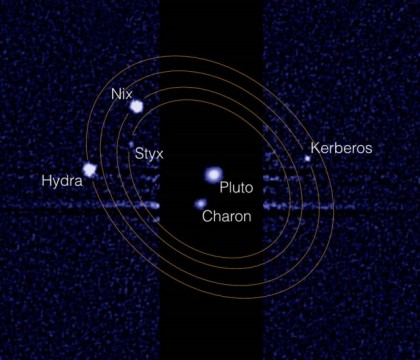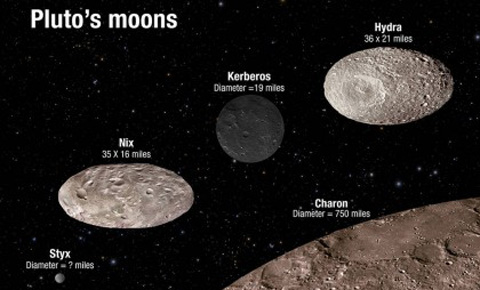New data on Pluto’s moons show that the system is more bizarre than previously thought.
What makes Pluto so interesting? (Hint: it’s not related to the controversy over whether or not it qualifies as a planet.) The answer, in part, lies within Pluto’s four smallest moons. This gaggle of bizarre objects simultaneously exhibits chaotic and highly organized properties. For example, their orbits are packed together so tightly, it’s a puzzle why they haven’t crashed into one another yet.

As astronomers have discovered one Plutonian moon after another (now at five: Charon, Hydra, Nix, Kerberos, and Styx), they have struggled to connect all the dots to have the satellite system make sense. Now, an analytical study of Hubble Space Telescope images, taken over the past decade by Mark Showalter (SETI Institute) and Douglas Hamilton (University of Maryland), supports some theories and also raise questions about the moons’ influences and compositions. Their analysis appears in the June 4th issue of Nature.
Resonance to the Rescue
Two of the big questions about Pluto’s satellite system concern how its moons got into their present formation, and how they manage to stay there.
The system was almost certainly created by an impact event, in which two large bodies collided and spewed fragments into their vicinity. These bodies eventually became Pluto and Charon, and the fragments became the other four moons. The strongest evidence for this theory, aside from Pluto’s tipped spin axis, is the highly organized way in which Hydra, Nix, Kerberos, and Styx orbit Pluto and Charon.
“The two ways to make satellites are by capturing them, or having them form or survive after a big impact,” explains Scott Kenyon (Smithsonian Astrophysical Observatory), who wrote a Nature opinion piece on the findings. In order to be captured, objects must enter into a planet’s Hill sphere, the region around a planetary body where its gravitational pull is greater than the Sun’s. If these four satellites were captured, their orbits should be configured randomly around Pluto, with random inclinations and orbital distances. Instead, they orbit in very nearly the same plane and surprisingly close to Pluto and Charon.
“The fact that they’re closely packed and all in one plane is consistent with a picture of them arising out of a giant impact,” Kenyon explains.
Yet, there’s a little problem in the system: the moons are also very close to one another, which is bad news for the long-term stability of their orbits.
Pluto and Charon are a binary system, which means that each circles around their common center of gravity. The four smaller moons in turn orbit around the pair and experience variable gravitational pulls as they approach and recede from Pluto or Charon. The result is a series of wiggles in the moons’ orbits. But since the moons are crowded so closely together, any disruption could potentially push them within range of one another’s gravity fields. Those tugs would further throw their orbital balance out of whack.
So how do moons that orbit with no room for wiggles keep their distance?
The solution appears to be a special three-body resonance. Hydra, Styx and Nix’s’ orbital periods are linked in ratios that prevent them from ever lining up in a row, which could permanently disrupt the system. Astronomers suspected for some time that resonances were at work, and Showalter and Hamilton have confirmed their existence with Hubble’s very precise measurements.
But the story is not over yet.
Chaotic Rotation
Showalter and Hamilton discovered something else in the Hubble images, which was that Nix and Hydra were rotating chaotically.
Except for Saturn’s moon Hyperion, virtually all the moons in our solar system orbit their planets synchronously: their spin rate is the same as their orbital period. This means that the moon always points the same side at its host planet (as our own Moon does—that’s why we never see the lunar farside from Earth). It is the natural state for moons. Hyperion, and now Nix and Hydra, are bizarre deviations from this state, because it is impossible to predict which of their sides will face their host planets and when.
We don’t really know what causes these chaotic rotations, but Showalter and Hamilton suspect that Nix and Hydra’s situation might have to do with Pluto and Charon’s binary configuration. The fluctuating dynamics could be throwing the moons into chaos.
“If you can imagine what it would be like to live on this body, it’s a very strange world,” Showalter said of Nix in a NASA teleconference. “You would literally not know if the sun is coming up tomorrow.”
Strange Colors

NASA / STScI / Showalter
The final mystery in the new findings had to do with Kerberos’s surprisingly dark color. The rest of Pluto’s small moons appear very bright, probably close to Charon’s reflectivity of 40%. (The Moon’s is 12%.) This is puzzling because if the moons were indeed formed after an impact, and therefore from the same spewed fragments, then how could Kerberos look so different?
It could be coincidence, “like when a kid goes to a birthday party and gets the last piece of cake,” Kenyon muses. Or it could be something else entirely.
What’s next?
The spacecraft New Horizons is scheduled to fly by Pluto just six weeks from now, on July 14th, and its upcoming observations might help answer some of the questions raised by Showalter and Hamilton, such as the Kerberos-color enigma. The resonance mystery might be more difficult, since it would take centuries to gather enough data to unravel the details of its long-term influence on the system.
And astronomers are always hoping to learn more about Pluto and its moons, not only because it is unique and full of tantalizing mysteries, but also because of its similarity to some exoplanetary systems that are too far away for us to study up close.
“If you scale Pluto-Charon up to the size of two stars, it then becomes an analogue for a circumbinary planetary system,” Kenyon explains.
Astronomers know of about a dozen circumbinary planetary systems discovered with Kepler. In these systems, planets orbit a binary star just like Pluto’s four small moons orbit it and Charon. They are likewise arranged in a compact pattern and situated at similar distances from their host stars. Sometime, in the near or distant future, astronomers might be able to use the tools and techniques they are using now to study Pluto, to study its distant stellar cousins.
Read the rags-to-riches story of Clyde Tombaugh, the discoverer of Pluto.
 1
1








Comments
Jamie-Dillon
June 6, 2015 at 12:25 am
Isn't it possible for moons to form in the same timeframe as the parent body, rather than only by impact or capture? Isn't that the best theory, for example, for the formation of Jupiter's Galilean moons?
You must be logged in to post a comment.
You must be logged in to post a comment.